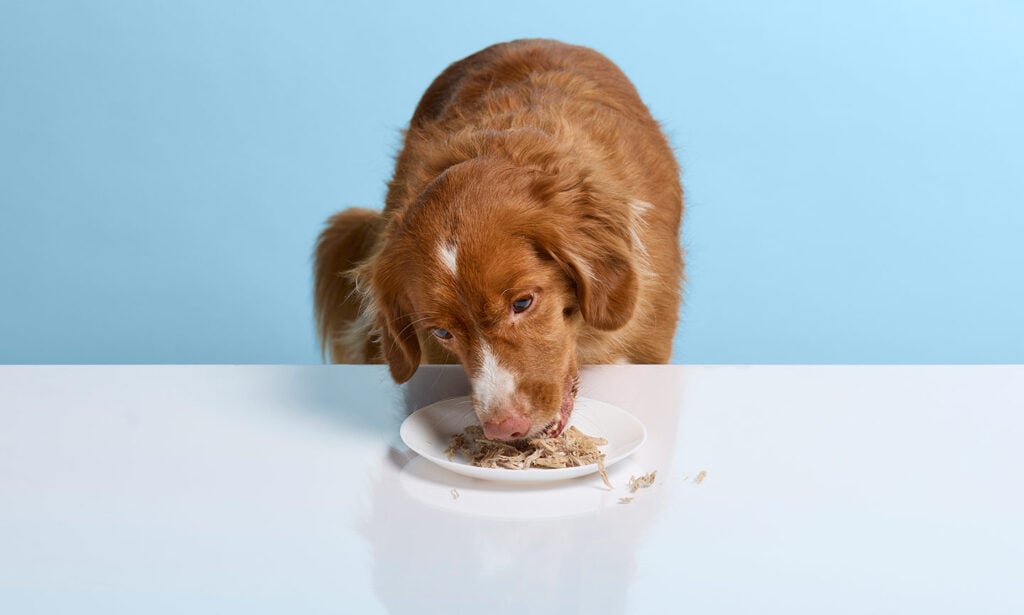You’ve just cooked up some delicious pork chops (or maybe some pork ribs). The aroma is wafting through your home, making mouths water (and not just the human kind). As you sit down to savor your meal, your dog’s pleading eyes are fixed on you. Naturally, you wonder, “Can dogs eat pork? Or, is pork bad for dogs?”
The answer depends on the kind of pork and how it’s cooked and served. Plain, well-cooked pork is generally safe for dogs in small amounts. However, processed pork (like bacon) and pork that’s seasoned, salted, marinated or smothered in BBQ sauce should be avoided. (Unless, of course, you make this dog-friendly, vet-approved BBQ sauce recipe.)
We spoke to a vet expert to understand the dos and don’ts of serving pork to your canine companion.
Click to jump to each section:
How Much Pork Can I Give My Dog? And How Often?
When treating your dog to pork, always stick to lean cuts of pork (like tenderloin or loin chops) that are fully cooked and free of any salt, onion, garlic, spices, sauces or marinades.
As for how much cooked, plain pork can you give your dog as a treat, keep the 10 percent treat rule in mind:
Treats—including pork—should never make up more than 10 percent of your dog’s daily caloric intake. Their primary nourishment should come from high-quality dog food that meets their comprehensive nutritional needs.
More specially, here are guidelines to follow for occasionally treating your dog to pork:
- Very small dogs (2-20 pounds): 1-2 pieces (1/2-inch long x 1/2-inch thick)
- Small dogs (21-30 pounds): 1-2 pieces (1/2-inch long x 1/2-inch thick)
- Medium dogs (31-50 pounds): 2-3 pieces (1/2-inch long x 1/2-inch thick)
- Large dogs (51-90 pounds): 3-4 pieces (1/2-inch long x 1/2-inch thick)
- Very large dogs (91+ pounds): 4-5 pieces (1/2-inch long x 1/2-inch thick)
Human food aside, pork is also a popular primary meat ingredient in many store-bought dog foods. If this is the case with the dog food you’ve selected, simply follow the feeding guidelines on the packaging. These instructions are designed to ensure your dog receives a balanced diet and adequate nutrition.
5 Ways to Safely Treat Your Dog to Pork
There are several ways you can allow your dog to enjoy pork without any adverse health effects. Here are some ideas:
1Serve Plain, Cooked Pork
While this might sound boring to us humans, we guarantee your dog will be thrilled with this treat!
- Boil plain loin chops or tenderloin in water until thoroughly cooked (about 30 minutes). Do not add any oil, seasonings, spices or sauces.
- Cut the cooked pork into small pieces, remove any bones, and treat your dog based on the chart above. You can also add the pork bits to their regular dog food.
Save leftovers in the fridge (up to three days) and/or the freezer for later use.
2Make a Pork "Gravy"
Make a simple, dog-friendly gravy. Here’s how:
- Boil a lean pork cut.
- Once cooked, blend the pork with some dog-friendly bone broth (like Brutus Bone Broth) to make a smooth, pourable gravy.
- Drizzle the mixture over your dog’s regular kibble for a tasty, tail-wagging topping.
3Offer a Pork-Stuffed KONG
Some dog toys, like KONG Classic Dog Toy, allow for stuffing with treats. You can stuff these toys with a combo of your dog’s regular kibble and a few pieces (depending on their size) of plain, cooked pork or pork “gravy.”
This provides not only a tasty reward, but also a fun and engaging activity for your dog.
4Seek Out Store-Bought Dog Food with Pork
Many high-quality dog food brands feature pork as a primary ingredient. If your chosen brand offers pork as a flavor, simply follow the feeding guidelines on the packaging.
Here are a few good options:
Temporarily out of stock
5Offer Pork-Based Dog Treats
Because dogs go crazy for pork, many store-bought dog treats include pork or pork flavoring. These high-value treats work great for training, entertainment or just showing your dog some love.
A few good options include:
Benefits of Giving Your Dog Pork
Pork, often overshadowed by other meats like chicken or beef in the canine diet, offers a variety of benefits when served appropriately.
Here’s why considering pork as a treat or main ingredient in your dog’s diet can be beneficial:
- It offers high-quality protein: Pork is an excellent source of protein, offering all 10 amino acids a dog needs in their diet. Protein plays a crucial role in building and repairing tissues and producing enzymes and hormones, and is a necessary ingredient in proper dog nutrition.
- It’s rich in essential vitamins and minerals: Pork is a good source of B vitamins (particularly B6 and B12), which play a vital role in brain function and the formation of red blood cells. Pork also provides minerals like potassium (needed for nerve and muscle impulses) and zinc (supports a strong immune system).
- It makes for a high-value treat: Pork’s rich and savory taste can make it a high-value treat in the eyes of many dogs. Given its palatability, it can be effectively used in training sessions, acting as a powerful motivator and reward.
- It can serve as an alternative protein source: For dogs who may be allergic or intolerant to more common protein sources like chicken or beef, pork can serve as an alternative, helping to diversify their diet and reduce allergic reactions.
Risks of Giving Your Dog Pork
While pork can be a nutritious and tasty treat for many dogs, it’s essential for pet parents to be aware of potential risks associated with its consumption.
Here are the potential dangers of giving your dog pork:
- Parasitic infections: Undercooked pork and raw pork can carry parasites that are harmful to dogs. For example, the parasite Trichinella spiralis, a roundworm, causes trichinosis, a condition that can result in digestive issues, muscle inflammation and fever. Always ensure the pork is cooked thoroughly to kill potential parasites and harmful bacteria.
- Bone hazards: We humans love gnawing the meat off of rib bones, and may wonder if it’s OK to give what’s left to our pups. But can dogs eat pork bones? Absolutely not. Pork bones, especially cooked bones, can splinter easily. These fragments are a choking hazard and can cause a blockage within a dog’s digestive system.
- Toxic ingredients: Pork prepared for human consumption is typically seasoned with ingredients like onion powder, garlic powder and other spices. Learn why onion, garlic and other spices should be avoided by your pooch.
- Salt intake: Processed pork products, such as ham or bacon, typically contain high levels of salt. Excessive salt can lead to increased thirst and urination in dogs, and in extreme cases, salt poisoning.
- Obesity risk: Like any treat, overfeeding pork (especially fatty cuts), can contribute to weight gain. Obesity is a growing concern in the pet world and can lead to numerous health issues, including joint problems and heart disease.
FAQs About Pork and Dogs
Q:
Is fatty pork safe for dogs?
Q:
What happens if my dog accidentally eats pork?
A:If your dog eats plain pork that’s boneless and well-cooked, there’s no need to worry—that’s perfectly safe for dogs in moderation.
If your dog ate pork that was seasoned (especially with garlic onion or garlic), contained bones, or was raw or undercooked, contact your veterinarian or the ASPCA Pet Poison Control Center at (888) 426-4435 immediately for guidance.
Q:
What meat should dogs not eat?
Q:
What is the best type of meat for dogs to eat?
Keep your pup away from these human foods:
Share:



















